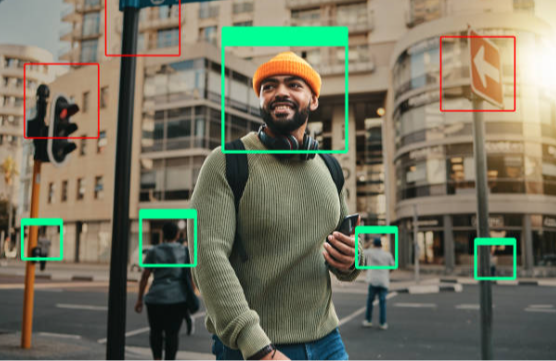
Can a Face Recognition System Detect a Psychopath?
Have you ever wondered if someone's face could reveal their true nature? With facial recognition technology becoming ever more sophisticated, the question arises: can this technology see right through us, even identifying personality disorders like psychopathy? In this blog post, we'll delve into the science behind both face recognition and psychopathy, exploring the possibilities and limitations of using AI to read minds (or at least facial expressions).
What is Facial Recognition?

Facial recognition is a biometric technology designed to identify or verify individuals based on their unique facial characteristics. Technically, it works by analyzing and comparing patterns of facial features extracted from images or video frames. These patterns include measurements between key facial landmarks such as the eyes, nose, and mouth, as well as the overall shape and contours of the face.
Simply put, facial recognition mimics the human ability to recognize faces in a crowd, for example. Using algorithms, this technology examines and identifies specific features unique to each person, providing computers with the capability to "see" and recognize faces with the speed and precision of machine learning.
Facial recognition has a wide range of applications and the most popular use case is lock screen technology for smartphones. A glance at your phone can unlock it instantly, eliminating the need to enter a passcode or remember a pattern. Setting up facial recognition on a smartphone involves teaching the device to recognize your face. The phone camera captures a series of images during registration, collecting different viewpoints and expressions to create a digital blueprint of your facial features.
When you attempt to unlock your phone, the front-facing camera activates and scans your face, noting critical features such as the distance between your eyes, the shape of your nose, and the angles of your jaw. It compares these features with the stored blueprint. If there is a match within a tiny margin of error, the phone unlocks instantly.
Thus, whether unlocking a smartphone or identifying individuals in surveillance footage, facial recognition technology relies on analyzing and matching unique facial features against stored data.
Can a Face Recognition Software Detect a Psychopath?
No, the current face recognition systems cannot detect psychopathy. Face recognition technology is designed to identify and verify individuals based on their facial features, but it cannot diagnose or infer complex psychological traits such as psychopathy.
Psychopathy is a personality disorder characterized by specific behavioral and emotional traits, such as lack of empathy, manipulativeness, and antisocial behaviors. Diagnosing psychopathy typically involves comprehensive psychological assessments, including interviews, behavioral observations, and standardized psychometric tests conducted by trained professionals. These assessments consider a range of factors beyond physical appearance, such as personal history, emotional responses, and interpersonal behaviors.
While some research explores the possibility of linking certain facial expressions or micro-expressions with emotional states or traits, this area is highly speculative and not reliable for diagnosing psychopathy. The relationship between facial expressions and psychological traits is complex and influenced by many variables, making it unsuitable for accurate assessment through face recognition technology alone.
The Limitations of Face Recognition to Detect a Psychopath

Face recognition technology has significant progress in recognizing people based on their unique facial features. However, the potential of employing this technology to detect complex psychological qualities such as psychopathy raises a number of concerns and constraints. Here's an in-depth look at why facial recognition is ineffective for detecting psychopathy.
Complexity of Psychopathy
Psychopathy is a complex personality disorder distinguished by characteristics such as lack of empathy, manipulativeness, and antisocial behavior. These characteristics are not reflected in facial structure or static photographs, but are more accurately assessed through behavior, personal history, and psychological assessments.
Feature Extraction Limitations
Face recognition systems evaluate physical factors such as eye distance, nose shape, and facial contours. Psychopathy, on the other hand, is an internal psychological state that lacks direct physical signs that current face recognition algorithms can detect and assess.
Dynamic vs. Static Analysis
Psychopathy is generally manifested as dynamic behaviors and interactions rather than static physical characteristics. While some academics investigate microexpressions and minor facial clues to infer emotions or intents, these analyses necessitate real-time, context-aware evaluation, which goes well beyond the static or isolated image analysis commonly conducted by face recognition software.
Potential for Integrating Psychological Analysis with Face Recognition
The idea of integrating psychological analysis with face recognition technology sparks both excitement and caution within the realms of artificial intelligence and psychology. While there are exciting prospects, serious obstacles and ethical concerns must be addressed. Here's an overview of the potential and the challenges involved:
Theoretical Possibilities
Behavioral Cues and Micro-Expressions
One of the most promising areas is the study of microexpressions and small facial movements, which can reveal information about a person's emotional state. Advanced algorithms may identify transient expressions that people overlook, providing a greater knowledge of emotions such as fear, rage, or happiness, which could indirectly contribute to psychological profiling. Learn more about emotion recognition here: Emotion Recognition API.
Enhanced Security Measures
Integrating psychological analysis with face recognition could enhance security systems by identifying individuals who exhibit signs of stress or deceit. Airports and other high-security settings, for example, could benefit from real-time monitoring that flags individuals for additional screening based on behavioral clues discovered in their facial expressions.
Mental Health Monitoring
In healthcare, combining these technologies may provide new approaches to monitor mental health. For example, persons suffering from sadness or anxiety may develop specific facial patterns over time. Continuous monitoring using facial recognition could notify caregivers to changes in a patient's emotional state, potentially leading to opportune interventions.
Current Research and Development
AI and Emotional Analysis
Researchers are looking into how artificial intelligence might be trained to understand complex emotional states via facial analysis. Large datasets of facial expressions associated with confirmed emotional states are used to train machine learning algorithms. Such developments may result in systems that better grasp human emotions and deliver more sophisticated psychological insights.
Interdisciplinary Approaches
Collaboration between psychologists, neuroscientists, and AI developers is crucial for creating systems that integrate psychological analysis with face recognition. These interdisciplinary efforts aim to build more accurate models that respect both the technical capabilities of AI and the nuanced understanding of human psychology.
Ethical Frameworks
Developing robust ethical frameworks is an ongoing part of the research. Ensuring that the technology is used responsibly, protecting individuals' privacy, and preventing misuse are critical to gaining public trust and acceptance.
Conclusion
In summary, detecting psychopathy requires thorough psychological evaluation, and face recognition software does not have the capability to perform such assessments. However, that's not the end of the road. Research is ongoing into whether facial expressions, head movements, and even subtle details like how long someone holds eye contact might offer clues about psychopathic tendencies. This is in its early stages, but it highlights the fascinating possibilities of AI in behavioral analysis.
